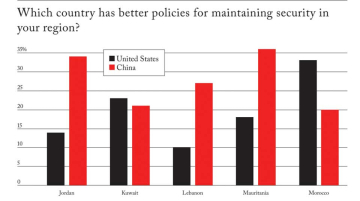
By Sama Aziz and Raphael Angieri
Five months since the overthrow of President Bashar al-Assad and subsequent consolidation of power by insurgent leader Ahmed al-Sharaa and his militant faction Hayat Tahrir al-Sham (HTS), Syria’s international repositioning is well underway. Global powers have been active in courting the new regime, with France, Germany, and Russia, among many others, sending dozens of high-level delegations to the capital of Damascus, first to meet with interim authorities, and then to build ties with the transitional government formed in late March under now-President al-Sharaa. On May 13, U.S. President Donald Trump announced his intent to lift sanctions imposed on Syria during the Assad era, joining Europe in a broad Western push toward normalization.
Some countries in the Middle East have gone further, offering material and financial support aimed at stabilizing the situation on the ground and shoring up the fledgling regime. In January, Qatar indicated willingness to subsidize the salaries of Syria’s government employees, began providing Syria with natural gas in March, and announced in April—jointly with Saudi Arabia—a commitment to repay Syria’s outstanding World Bank debt of around $15 million.
Yet as the usual suspects jockey for influence within this rapidly evolving geopolitical landscape, one emerging regional powerbroker appears conspicuously absent—China.
China’s positioning in Syria is unique, particularly as an economic actor. In the face of international sanctions prohibitive to many, China has in recent decades established itself as one of Syria’s primary commercial partners via robust networks of intermediated business relationships. China-Syria trade, conducted mainly through third countries and often within legal gray areas or illicitly, has withstood years of war and now regime change.
If properly leveraged by both sides, the existing human networks enabling this trade could serve as the basis for a consequential economic partnership. With autonomous agents on both sides having set the stage for pragmatic cooperation targeting real Syrian demand, the two countries’ willingness to expand the relationship—and ability to navigate security and political challenges to that end—could prove instrumental to Syria’s reconstruction and the emergence of a new Syrian economy.
Fields Left Fallow: China’s Position in Syria
China’s diplomatic outreach to Syria has been muted in the wake of Tahrir, or Liberation, with the last major public communication from the Chinese embassy in Damascus being a December 5 notice advising citizens in Syria to depart from the territory. Sources in Damascus and Beijing affirm that the embassy has since then quietly suspended consular and other services, hindering the renewal of political ties and local engagement.
Beijing has not received—or has not openly acknowledged—any new ambassadorial nomination from Damascus, and while the Syrian embassy in Beijing’s Chaoyang District now proudly flies the three-starred flag of the revolution, an exchange with current Syrian Ambassador to China Muhammad Khaddam—in post since July 2022, through the regime change—revealed that his own communications with Damascus have largely been limited to routine bureaucratic affairs.
Notwithstanding this diplomatic lull, China’s overall ground presence has remained comparatively robust—and that not chiefly a result of the few publicized meetings Chinese officials have held with their newly appointed Syrian counterparts. More impactful than these diplomatic exchanges—at least in the view of Sari Kabbour, a Syrian CEO based in Damascus—has been the continued engagement of Chinese businesspeople still operating within Syria, many having opted to remain through the upheaval, promptly adapting to the shift in power in order to maintain commercial activities.
Al-Sharaa’s transitional government is actively courting a range of international partners for reconstruction and development support, while both Beijing and Damascus remain publicly noncommittal—particularly regarding the sensitive issue of security arrangements involving foreign fighters.
Officially recorded trade flows between China and Syria would suggest relatively negligible (and largely one-sided) exchange. According to Chinese customs data, China’s direct exports to Syria totaled just $357 million in 2023, while Syrian goods imported by China over the same period amounted to a trifling $1.5 million.
But these numbers understate the extent of actual exchange, and particularly the volume of exports from China—volume which is readily apparent upon even a casual stroll through souqs from Damascus to Aleppo, brimming as they are with textiles, electronics, and other commodities made in China. Given recorded Chinese export volumes into Iraq, Lebanon, and Jordan of $49.7, 2.4, and 5.7 billion, respectively, for 2023, the true value of Chinese exports to Syria is more likely to be in the realm of at least several billion dollars annually.
The difficulty of precisely defining the volume of China-Syria trade lies in the nature of prevailing trade modalities. Faced with the extraterritorial reach of US sanctions, individual economic actors on both sides have worked over decades to circumvent barriers by operating through third countries, establishing intermediated trade networks that are still functional today.
As before the fall of Assad’s regime, Chinese products bypass sanctions via the re-export market, with businesses delivering products to the ports and cities of Syria through third markets—often, Dubai’s Jebel Ali Port—rather than by direct routes.

Despite evolving security concerns, these economic activities largely remain as they had been, with the chief difference being fewer restrictions and false pretenses on the Syrian side, where steep taxes and fines had previously been levied from all transactions as part of the regime’s own survival strategy under sanctions. Today there is no need for Syrian businessmen to operate under the table or offer financial inducements to officials, with the current authorities having yet to impose regulations or oblige businessmen to conduct trade via official channels.
Concurrent with this reduction in regulatory and other interventions on the Syrian side, however, new obstacles to trade have emerged. Notably, Syrian business travel to China has taken a hit, as Syrians are no longer able to apply for visas at the still-shuttered Chinese consular office.
According to Kabbour, who has engaged in trade with China for more than a decade, the criteria for receiving a Chinese business visa had been stringent to begin with—requiring, among other things, a Syrian government reference authorizing one to engage in economic activities. Whether a more relaxed procedure will be instituted as the two countries establish new terms of engagement has yet to be seen. In the meantime, Syrians businesspeople’s access to China has been curtailed.
What to Expect From China Next?
China’s apparent reluctance to invest diplomatically at this stage is perhaps not surprising, given its relatively low levels of engagement in Syria even under its Assad-era “strategic partnership” with the country. Despite China’s emphatic defense of Syria’s sovereignty and consistent veto of UN Security Council resolutions condemning the regime for its actions during the Syrian Civil War, material support seldom followed. Unlike Russia, China was never a major source of armaments for Assad’s military, nor did it extend significant backing to the Ba’ath party. Contributions to Syrian relief efforts paled in comparison to those in neighboring countries such as Iraq, with China’s most prominent gesture to Syria being the donation of 200 passenger buses between 2019 and 2022.
But on the ground, many Syrian citizens express the same sentiment regarding their country’s near future: Restoring infrastructure in the war-torn country is second in importance only to boosting supply of essential goods. China’s unique offering as a manufacturing and contracting giant could be consequential in both of these respects, with the dense networks of commercial relationships already existing between China and Syria offering a foundation on which to build.

(Photo by Hibatullah Barakat / Middle East Images / Middle East Images via AFP)
China nevertheless remains cautious—more so than many other powers with vested interests in the country and wider region. The official Chinese stance has remained consistent in the months of al-Sharaa’s consolidation of power, featuring a refrain of support for a “Syrian-led and Syrian-owned political process,” accompanied by insistence that the government address the “serious threat posed by foreign terrorist fighters.”
Chinese delegations have met with Syrian officials, including the new foreign minister, Asaad al-Shaibani, and minister of agriculture Mohammed al-Ahmed, but these encounters have been attended by Chinese diplomats already working in the country rather than new missions sent from Beijing, suggesting a reluctance to commit additional resources or prematurely signal amity with the al-Sharaa government.
Beyond the obstacle to foreign investment in Syria posed by international sanctions, one major subject of concern for China, to date, has been that of Uyghur fighters and their role in “New Syria.” Having played a role in the armed coalition that toppled the Assad government, foreign militias occupy a position of considerable leverage with respect to al-Sharaa, making it difficult for him to exclude them entirely from the country’s security apparatus, if not from the transitional government itself.
In contrast, many Syrians express reservations about non-Syrians being elevated to high-ranking positions, viewing such appointments as a potential threat to national sovereignty and post-war self-determination. Signals from the regime have been mixed, with foreigners reportedly not prevalent among security forces stationed in urban areas since the transition, but, at the same time, Uyghurs publicly named to prominent roles within the restructured armed forces.
Lu Xiaoyu of Peking University, whose peace and conflict research has focused on the Levant and specifically Syria, notes that China’s willingness to contribute financially and operationally to the rebuilding of Syria does indeed appear to be contingent on al-Sharaa addressing Chinese concerns regarding the issue of foreign fighters. This assessment is supported by the precedent of China’s position with respect to Afghanistan in the wake of the Taliban takeover, where the “necessary conditions for […] normal exchanges” between Afghanistan and China ostensibly included the governing body “resolutely crack[ing] down” on “terrorist forces” such as the Uyghur East Turkestan Islamic Movement.
That said, in the case of Syria, it is noteworthy that the convergence between Beijing’s stance regarding foreign militants and the Syrian public’s own sentiment may offer al-Sharaa an opportunity to appease both parties at the same time.
Conclusion
The foundations for China-Syria economic engagement were laid well before the current political transition, driven by individuals on both sides pursuing trade and investment opportunities under the duress of international sanctions and in the absence of explicit intergovernmental cooperation. The longstanding network of informal economic ties built during the Assad era could very well give China a distinct first-mover advantage over other actors now seeking influence in post-Assad Syria, offering not only a head start in establishing new trade corridors, but also a pathway to more comprehensive partnerships.
Yet the political shift in Damascus has introduced uncertainties. Al-Sharaa’s transitional government is actively courting a range of international partners for reconstruction and development support, while both Beijing and Damascus remain publicly noncommittal—particularly regarding the sensitive issue of security arrangements involving foreign fighters. This mutual caution has slowed the formation of new, strategic ties, narrowing the window for China to assert itself as an economic stakeholder in Syria’s recovery.
Whether Beijing leverages existing commercial networks to expand the bilateral relationship via state-level cooperation, notably with respect to much-needed infrastructural investment—or retreats into a more risk-averse pragmatism—will shape its regional role for years to come. For now, one thing remains certain: The actors who built the already remarkably robust China-Syria trade relationship are moving ahead with or without official endorsement—and show no signs of slowing down or changing course.
Sama Aziz is the Creative Director and Co-Founder of the Sino-Arabica Project, and Raphael Angieri is the Editor-in-Chief and Co-Founder of the Sino-Arabica Project. The views expressed in this article are solely those of the authors and do not purport to reflect the position of the Sino-Arabica Project. Special thanks to Sahar al-Basha, Ambassador Muhammad Khaddam, and Sari Kabbour for their contributions to the research process. This article was originally published on the Sino-Arabica Project website and was reprinted here with permission.






